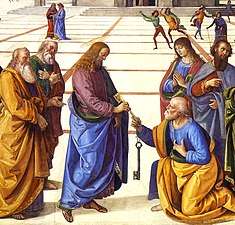Consecrator
In the Canon law of the Catholic Church, a consecrator is a bishop who ordains a priest to the episcopal state. The term is also used in Anglican communities.
 |
| Part of a series on the |
| Canon law of the Catholic Church |
|---|
|
Jus antiquum (c. 33-1140)
Jus novum (c. 1140-1563) Jus novissimum (c. 1563-1918) Jus codicis (1918-present) Other |
|
Sacraments
Sacred places
Sacred times |
|
|
Supreme authority, particular churches, & canonical structures Supreme authority of the Church
Supra-diocesan/eparchal structures
|
|
|
Temporal goods (property) |
|
Canonical documents |
|
Procedural law Pars statica (tribunals & ministers/parties)
Pars dynamica (trial procedure)
Election of the Roman Pontiff |
|
Legal practice and scholarship
Academic degrees Journals and Professional Societies Faculties of canon law
Canonists |
|
|
History
The church has always sought to assemble as many bishops as possible for the election and consecration of new bishops.[1] Although due to difficulties in travel, timing, and frequency of consecrations, this was reduced to the requirement that all comprovincial (of the same province) bishops participate. At the Council of Nicæa it was further enacted that "a bishop ought to be chosen by all the bishops of his province, but if that is impossible because of some urgent necessity, or because of the length of the journey, let three bishops at least assemble and proceed to the consecration, having the written permission of the absent."[1] Consecrations by the Pope were exempt from the three bishop requirement.[1] The reason for the three bishop requirement was stated by St. Isidore: "[The custom] that a bishop should not be ordained by one bishop, but by all the comprovincial bishops, is known to have been instituted on account of heresies, and in order that the tyrannical authority of one person should not attempt anything contrary to the faith of the Church."[1]
A "Principal Consecrator" is the primary bishop who ordains a new bishop.
Validity
Although for validity, only one bishop (with a papal mandate) is needed to raise a priest to the episcopal state, it remains a strict rule of the Church that there should at least two co-consecrating bishops; with the sole exemption being made in missionary countries where it is very difficult to bring three bishops together. In those cases, the Holy See allows two priests to act as assistants to the consecrator.[1] For the ordination of a diocesan bishop, the principal consecrator will usually be his metropolitan archbishop assisted by two other bishops. Once a new diocesan bishop is ordained, he then must be installed as bishop of his see, either during the service or at a later date.[2]
Co-Consecrators
The term "Principal Co-Consecrator" is used to designate the bishop who assists the Principal Consecrator in the ordination of a new bishop. Co-consecrators are not mere witnesses to the fact that the consecration has taken place; rather, by taking part in it, make themselves responsible for its taking place.[3][1][4][5][6] The consecrator and the two assistant bishops impose hands upon the head of the consecrandus saying "Accipe spirit sanctum."[7] As three bishops take part, the Church is more certain of the validity of the ordination which requires only one of them for validity."[3]
While there are often other bishops in attendance at an episcopal ordination, they are not designated as co-consecrators and are generally not recorded in any documentation supporting the elevation of a new bishop.
See also
- Bishop (Catholic Church)#Consecration of bishops and eparchs
References
- Smith, S. (1908). Co-consecrators. In The Catholic Encyclopedia. New York: Robert Appleton Company. Retrieved February 28, 2017 from New Advent
- Additional reference
- Beal, John P. (May 2000). New Commentary on the Code of Canon Law. Paulist Press. p. 1196. ISBN 9780809105021. Symbolically, the collegiality of the episcopate is apparent; practically, the Church is undoubtedly assured of the validity of the ordination, as three bishops participate in an ordination which requires only one of them for validity
- "GLOSSARY: Co-consecrator" Catholic-Hierarchy.org. David M. Cheney. Retrieved February 28, 2017 | A bishop who assists in the consecration of a new bishop. Normally, the Church uses three bishops to consecrate a new bishop, the one who is primarily responsible is called the consecrator, and his two assistant bishops are called co-consecrators. The purpose is to further guarantee that the new bishop is really being validly consecrated. Even if the consecrator has no valid intent or consecration, either one of the co-consecrators will still be able to supply validity. However, one bishop alone is enough to consecrate validly.
- Ruby, Griff. The Resurrection of the Roman Catholic Church: A guide to the Traditional Roman Catholic movement. p. 364.
- Lee, Frederick George (August 31, 2012). The Validity of the Holy Orders of the Church of England Maintained and Vindicated: Both Theologically and Historically, with Footnotes, Tables of Consecrations, and Appendices. Ulan Press. p. 230.
- McMillan, Sharon L. (September 1, 2005). Episcopal Ordination and Ecclesial Consensus. Liturgical Press. p. 216. ISBN 9780814661956.
